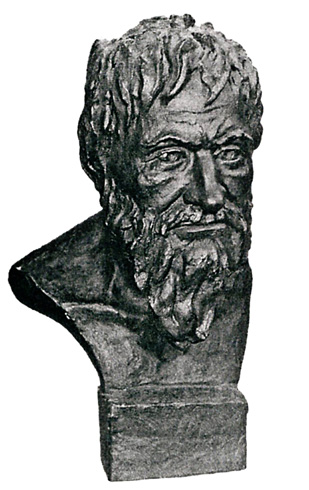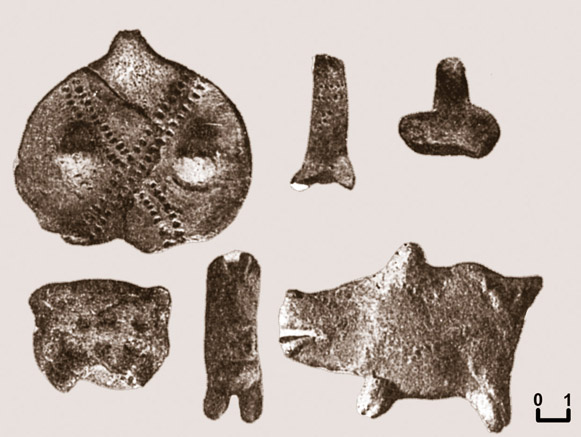Serednii Stih culture
Serednii Stih culture [Середньостогівська культура; Serednostohivska kultura] also referred to as Serednii Stih archeological culture complex or Serednii Stih cultural horizon. A Copper Age (Eneolithic, Chalcolithic) archeological cultural complex of the mid-5th to mid-4th millennium BC. Its features appear across a wide territory in the Black Sea steppe from the Dnipro River, the upper Donets River, the lower Don region, and the Sea of Azov in the east to the delta of the Danube River in the west. While initially the Serednii Stih designation was used to define a set of early Eneolithic archaeological features defining a break from the Neolithic hunter gatherer archaeological package in the lower Dnipro Valley, the term is now commonly used by western archaeologists to define a nomadic steppe people of the North Pontic steppe throughout the Eneolithic Period. To archaeogeneticists, Serednii Stih defines a group of prehistoric people carrying a mix of Eastern Hunter Gatherer (EHG) and Caucasus Hunter Gatherer (CHG) genetic ancestries, until the emergence of the genetic ancestry of the Yamna archeological culture complex in the second half of the 4th millennium BC. A significant number of scholars interpret Serednii Stih communities as some of the earliest known Indo-European populations.
The Serednii Stih culture appears in mid-5th millennium BC in the lower Dnipro region in the context of the late (Zasukha) phase of the Neolithic archaeological complex, generally referred to as the Dnipro-Donets culture, associated with the people who left extended burials of the Mariupol type. The term ‘Serednii Stih’ comes from an Eneolithic layer of the Serednii Stih archaeological site in the lower Dnipro River area on the outskirts of today’s city of Zaporizhia.
Serednii Stih pottery was shell-tempered with mostly conical or egg-shaped, but sometimes flat base. Pottery surface was carefully smoothed with a toothed stamp before firing. The ‘caterpillar’ twisted cord ornament, subsequently evolving into the braided cord ornament, appears on the ceramics of the later phase, replacing earlier ringed and traced ornaments. Based on the presence or absence of the cord ornament, Dmytro Telehin identified early, ‘pre-corded’ (Maiorka, Kvitiana), and late ‘corded’ (Deriivka, Moliukhiv Buhor) phases of Serednii Stih. Nadiia Kotova considers the Deriivka phase of Serednii Stih to be a separate Deriivka culture.
According to Valentyn Danylenko, monuments of the Serednii Stih type belong to the early phases of the Yamna archeological culture complex. Maria Gimbutas considered that there was one ‘kurgan’ culture in the Pontic-Caspian steppes, divided into Mykhailivka I, Serednii Stih, Mykhailivka II, and Mykhailivka III stages. Ukrainian archaeologists recognize Mykhailivka I as a separate culture that bordered Serednii Stih, extending to the south and southwest along the Black Sea shore. In this view, Mykhailivka I (Lower Mykhailivka culture) is synchronous with the Deriivka phase of Serednii Stih/Deriivka culture and Mykhailivka II and III belong to the post-Serednii Stih period and chronologically correspond to the Yamna archeological culture complex.
Serednii Stih communities buried their dead in ground burials, which, sometimes, formed burial complexes or necropoli. Serednii Stih’s early burials were inhumations in contracted on the side position, subsequently replaced by a supine position with flexed legs, although cremations are also known. Burial goods consisted of flint blades and personal adornments. Some Serednii Stih graves included anthropomorphic ‘scepters,’ the function and the origin of which are a subject of debate among archaeologists.
Early Serednii Stih and the closely related Khvalynsk archaeological culture of the north Caspian region took part in the development and function of the circum-Pontic trade network ca. 4700–4200 BC. Copper and personal adornments were exchanged through this network between the manufacturing centers on the west Pontic coast, northeast Anatolia, North Caucasus, and the Samara region on the middle Volga. This long-distance travel may have been aided by the use of boats and horses, although horseback riding in the early Eneolithic remains a debatable issue.
Serednii Stih’s cultural influences extend beyond their homeland in the lower Dnipro-Don region. The shell-tempered Serednii Stih pottery of the Cucuteni-C type appears on Trypillia culture settlements in Moldova and Right-Bank Ukraine of the second half of the 5th millennium BC. Close cultural contacts of Serednii Stih with populations of the Balkan-Carpathian region are evidenced from burials in Căinari in Moldova and Decea Mureşului in Transylvania, the latter standing out among the local monuments of Transylvania for its pronounced influence by Serednii Stih. These burials, like the Serednii Stih cemeteries, are characterized by the presence of ‘belts’ made of large mother-of-pearl piercings, hryvnas (necklaces) made of copper wire, flint knives, nuclei, and a significant amount of red ocher. In the northwest Pontic, Serednii Stih influenced the formation of the Usatove culture.
The climatic shift to colder and drier conditions during 4200–3900 BC led to the fragmentation of archaeological complexes in the North Pontic area. In the 4th millennium BC, Serednii Stih is represented by local steppe and forest-steppe groups. Serednii Stih in the forest-steppe areas of the Dnipro River Valley became more sedentary and began practicing agriculture and stockbreeding. Post-Stih groups in the steppe remained largely nomadic and continued to engage in intra-continental trade. Wagon transportation appeared in the steppe by the middle 4th millennium BC, likely revolutionizing trade and travel. Increasing influences on the steppe from the farming communities of the Trypillia culture and Maikop culture in the second part of the 4th millennium BC led to the formation of the Zhyvotylivka-Vovchansk cultural group. The rise of Zhyvotylivka-Vovchansk coincided with the emergence of the Core Yamna culture. Recent archaeogenetic studies indicate that populations of the Serednii Stih culture were direct genetic ancestors of the Core Yamna and thus, the broader Yamna archeological culture complex.
BIBLIOGRAPHY
Gіmbutas, M. The Relative Chronology of Neolithic and Chalcolithic Cultures in Eastern Europe North of the Balkan Peninsula and Black Sea. Chronologies in Old World Archaeology (Chicago–London, 1965)
Telehin, D. Seredn'o-stohivs'ka kul'tura epokhy midi (Kyiv 1973)
Kotova, N. S. Dereivskaia kul'tura i pamiatniki Nizhnemikhailovskogo tipa (Kyiv–Kharkiv 2013)
Nikitin, A. G., Videiko, M., Patterson, N., Renson, V. and Reich, D. ‘Interactions between Trypillian farmers and North Pontic forager-pastoralists in Eneolithic central Ukraine,’ PLoS One 18 (2023)
Nikitin, A. G. and Ivanova, S. ‘Long-distance exchanges along the Black Sea coast in the Eneolithic and the steppe genetic ancestry problem,’ in Preda-Bălănică, B. And Ahola, M. (eds.) Steppe Transmissions (Budapest 2023)
Alexey G. Nikitin
[This article was written in 2024.]
.jpg)


.jpg)